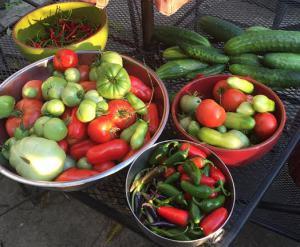
I have been gardening for enough years now to make a proclamation: I have a harvesting problem. I love to be in the garden. It brings me tremendous, uncomplicated joy. I start looking at seed catalogues when it’s still dark 16 hours a day.
I love planting peas by St. Patrick’s Day and tomatoes by 4th of July. I love watching our seedlings grow and puttering around with my coffee cup and hose to make sure everything is good and damp before the sun gets too hot. I even get a jolt of destructive pleasure from ripping weeds out of the ground.
But every year, the same thing happens. I watch the cucumbers flower and the peppers sprout and the tiny tomatoes start to turn pink. And then, I lose interest. This year, we had unpicked strawberries and withering blueberries and summer squash that were left to grow to the size of school buses. The basil bolted, and there are still figs on the tree. That’s not to say that we didn’t harvest anything. We did. We ate a lot of Greek salads and Caprese sandwiches, and there were nights we relied on the garden for entire meals. I made a few blueberry pies and garnished breakfast plates with handfuls of perfect Hood strawberries. But for whatever reason—like other years—I just wandered off and don’t finish the job with the same gusto I started it with.
This, of course, is a trait I–ahem–recognize. I have drawers full of mostly done but not complete knitting projects and files of photographs sorted but not glued down in their albums and a wispy contrail of ideas in various stages of half-assed-startedness.
And truth be told, for the past few months, I have been heavily dithering over revisions to a manuscript. Dithering doesn’t even quite cover it. Opening it. closing it. Sleeping over it. Tearing it apart. Putting it back together. Crying. Complaining to anyone who will listen. But not bloody finishing it.
Last Saturday, I spent the whole day at a conference. When I came home, I was shocked to find that David had ripped out the garden. He—as he put it—was prepping it for the fall planting of kale and fava beans. He left the three winter squash plants, but it was Goodnight, Irene to the rest of it. In the process, he picked every last tomato, red and green; all the cucumbers that weren’t the size of the children, and about 1,000 chiles and other peppers.
Needless to say, I am deep into the days of blanching and freezing tomatoes, canning green tomato salsa, and lining up hot sauce jars on every flat surface. My life is like Pablo Neruda’s great Ode to the Tomato, which begins:
The street
filled with tomatoes,
midday,
summer,
the light
splits
in two
halves
of tomato,
the juice
runs
through the streets.
In June
The tomato
cuts loose,
invades the kitchens,
takes over lunches,
sits down
comfortably
on sideboards,
among the glasses,
the butter dishes,
the blue saltshakers.
It has
Its own light,
A benign majesty.
So, as Neruda says at near the end of the poem: “it’s time!/let’s go!” I guess I’d better take his celebration of the harvest to my stovetop and my desk and get busy, despite my leanings to the contrary.
p.s. – Here’s an easy satisfying hot sauce recipe just in case you’re in the same boat!
Master Hot Sauce Recipe
From the Bon Apetít Test Kitchen
Ingredients
1 pound stemmed fresh chiles (such as jalapeño, serrano, Fresno, or habanero; use one variety or mix and match)
2 tablespoons kosher salt
1 1/2 cups distilled white vinegar
Preparation
Pulse chiles and kosher salt in a food processor until a coarse purée forms. Transfer to a 1-qt. glass jar, loosely screw on lid, and let stand at room temperature for 12 hours to ferment slightly.
Stir in vinegar and loosely screw on lid. Let chile mixture stand at room temperature for at least 1 day and up to 7 days. (Taste it daily; the longer it sits, the deeper the flavor becomes.)
Purée mixture in a food processor or blender until smooth, about 1 minute. Place a fine-mesh sieve inside a funnel. Strain mixture through sieve into a clean glass bottle. (Hot sauce will become thinner and may separate after you strain it; shake vigorously before each use.)
